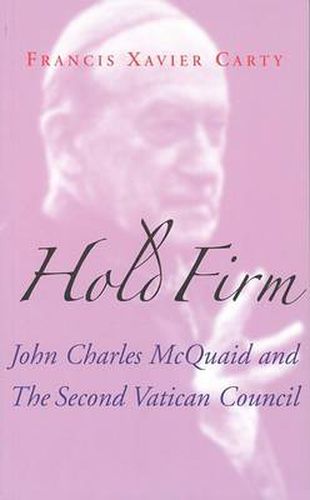Readings Newsletter
Become a Readings Member to make your shopping experience even easier.
Sign in or sign up for free!
You’re not far away from qualifying for FREE standard shipping within Australia
You’ve qualified for FREE standard shipping within Australia
The cart is loading…






Mention Archbishop John Charles McQuaid of Dublin to any Irish Catholic old enough to remember the 1960s and you will most likely be told that he came back from the Second Vatican Council and said there would be no change. Also, you may be given a strong expression of admiration for his efficient and farseeing management style and for his legendary kindness to the poor and the sick or, with equal strength, an utterance of disgust and dislike and complaint that he wouldn’t let Catholics go to university in Trinity College. Few will be neutral and even fewer will ever have met the man nor known him. The Council and its spirit of aggiornamento, or updating, the inspired dream of Blessed Pope John XXIII, was a landmark in the Catholic Church’s long effort to come to terms with the modern world.In the 1960s, those latter years of his 32-year episcopate, Dr McQuaid, approaching his seventy-fifth year and retirement, was thrust into a whirlwind of change and excitement. Attentive to everything that happened at the Council in Rome, and diligently attending every meeting during every session in the autumns of 1962 to 1965, he was seen as theologically conservative at a time when it was popular, especially in the media, to be liberal. He was torn between innate anxiety about sudden change and unquestioning obedience to every wish of the Pope. He was a man of contrasts, if not opposites, gentle and kind but authoritarian and strict, shy but forceful, indeed the most dominant and controversial Irish churchman of his age, exerting an influence that filtered into every area of public life.A certain aura glowed from Archbishop’s House, the ‘palace’ in Drumcondra, the aura of an all-seeing pastor whose prime concern was for the ‘simple faithful’ but at the same time a forbidding schoolmaster who seemed to be aware of everything that happened in his archdiocese. This book reaches behind the myths of John Charles McQuaid and describes how the dream of Pope John’s Council was lived out for the Archbishop and the 800,000 Catholics in his archdiocese.
$9.00 standard shipping within Australia
FREE standard shipping within Australia for orders over $100.00
Express & International shipping calculated at checkout
Stock availability can be subject to change without notice. We recommend calling the shop or contacting our online team to check availability of low stock items. Please see our Shopping Online page for more details.
Mention Archbishop John Charles McQuaid of Dublin to any Irish Catholic old enough to remember the 1960s and you will most likely be told that he came back from the Second Vatican Council and said there would be no change. Also, you may be given a strong expression of admiration for his efficient and farseeing management style and for his legendary kindness to the poor and the sick or, with equal strength, an utterance of disgust and dislike and complaint that he wouldn’t let Catholics go to university in Trinity College. Few will be neutral and even fewer will ever have met the man nor known him. The Council and its spirit of aggiornamento, or updating, the inspired dream of Blessed Pope John XXIII, was a landmark in the Catholic Church’s long effort to come to terms with the modern world.In the 1960s, those latter years of his 32-year episcopate, Dr McQuaid, approaching his seventy-fifth year and retirement, was thrust into a whirlwind of change and excitement. Attentive to everything that happened at the Council in Rome, and diligently attending every meeting during every session in the autumns of 1962 to 1965, he was seen as theologically conservative at a time when it was popular, especially in the media, to be liberal. He was torn between innate anxiety about sudden change and unquestioning obedience to every wish of the Pope. He was a man of contrasts, if not opposites, gentle and kind but authoritarian and strict, shy but forceful, indeed the most dominant and controversial Irish churchman of his age, exerting an influence that filtered into every area of public life.A certain aura glowed from Archbishop’s House, the ‘palace’ in Drumcondra, the aura of an all-seeing pastor whose prime concern was for the ‘simple faithful’ but at the same time a forbidding schoolmaster who seemed to be aware of everything that happened in his archdiocese. This book reaches behind the myths of John Charles McQuaid and describes how the dream of Pope John’s Council was lived out for the Archbishop and the 800,000 Catholics in his archdiocese.